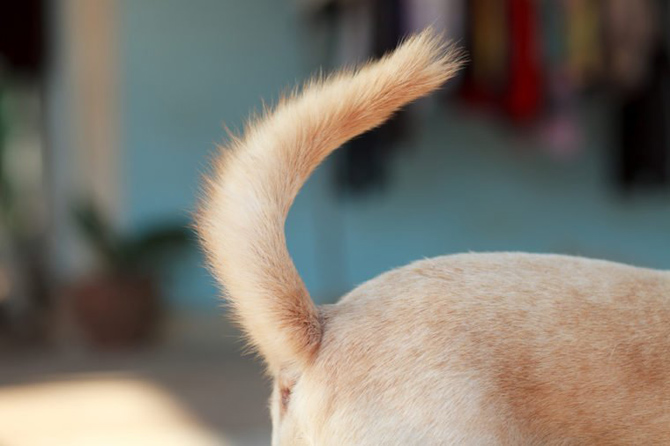Whether you’re a pet professional or simply a lover of dogs, finding out everything there is to know about dogs can be fun. Here are some interesting facts about a dog’s tail you might not know.
Certainly, a wagging tail can be a sign that a dog’s happy to see you—but not always! When it comes to a dog’s tail, it can say many things. For example, a low tail that wags slightly when a dog greets someone new is a sign of hesitation and uncertainty. It’s basically saying, ‘I want to like you, but I’m not sure yet!’
So what other interesting things does a dog’s tail tell us? Keep on scrolling for more intriguing truths about dogs’ tails.
8 fun facts about a dog’s tail
Long, short, fluffy or curly—dog tails come in all shapes and sizes, but they’re most than just a wagging wand. It just so happens they’re pretty useful.
1. A dog’s tail can talk
Dogs use their tails to communicate with one another. Different tail movements (AKA wags) mean different things. For example, a dog’s tail that wags to the right indicates openness and happiness. Whereas, when a dog’s tail wags to the left it could signal fear or uncertainty.
Of course, this means that dogs that have had their tails docked have a tricky time when trying to communicate!
2. Tail wagging is a learned behaviour
Just like humans, dogs must develop their communication skills. Tail wagging is a skill that puppies learn as they grow. It’s not until a puppy is approximately 4-6 weeks old that they begin using their tail to talk. They practice this skill with their mum and fur siblings.
3. Tails assist with balance
Similar to other animals with long tails, such as cats, possums and monkeys, a dog’s tail helps them balance.
4. Tails help disperse pheromones
When a dog wags its tail the muscles around the rectum contract, which puts pressure on the anal glands and triggers the release of pheromones.
5. Undercover dogs tuck their tails
When a dog tucks its tail under its body it covers its scent glands, which means fewer pheromones can escape. Thus, dogs that tuck their tails are intentionally keeping a low profile.
6. Tails don’t like cold temperatures
Limber tail syndrome is a thing! It’s associated with acute caudal myopathy, which is predominantly seen in working dogs that are exposed to cold temperatures and wet weather when working outdoors. When suffering from acute caudal myopathy dogs will wrap their tail in between their legs (AKA ‘limber tail syndrome’).
7. Tails are an extension of the spine
Did you know that a dog’s tail is, in fact, an extension of its spine? It assists the functioning of the dog’s hind body as a whole. The tail, however, has its own set of muscles, which makes it more flexible.
8. Tail docking is illegal
The surgical removal of puppies’ tails for aesthetic or cosmetic reasons is illegal in Australia. The ban came into effect in 2004 and since then it has been against the law to dock dogs’ tails unless there is a valid medical reason.
Who would have thought there were so many interesting facts about dogs’ tails? So next time you’re chatting to a client or customer, why not throw in a fun fact about their dog’s tail?
Got an interesting animal fact to share? Post it in the comments section below.
Related posts:
- Common pet questions you might be asked by clients
- Understanding common dog fears
- Global attitudes towards dogs
Main image source: Bell Nipon / Shutterstock
Latest posts by Liz Walden (see all)
- Pet health: Medicinal cannabis for pets - December 27, 2021
- What pet business insurance do I need? - November 17, 2021
- Pet sitters: how to take time off - November 15, 2021










Leave A Comment